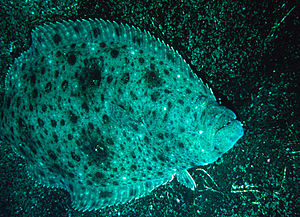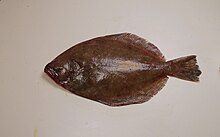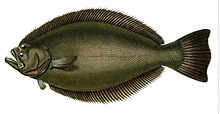Sham butt
| Sham butt | ||||||||||||
|---|---|---|---|---|---|---|---|---|---|---|---|---|

California flounder ( Paralichthys californicus ) |
||||||||||||
| Systematics | ||||||||||||
|
||||||||||||
| Scientific name | ||||||||||||
| Paralichthyidae | ||||||||||||
| Regan , 1910 |
The pseudobutte or large toothed flounder (Paralichthyidae) live in the Atlantic and Indo-Pacific , a few species also in brackish and fresh water. As with the butterflies (Bothidae), dog tongues (Cynoglossidae) and turbot (Scophthalmidae), the left side of the body, to which the eye moves from the later blind side, becomes the "top" of the flatfish.
features
Shamrocks are rather small flatfish, most of the more than 65 species are only around 30 centimeters long. The smallest species, Tarphops oligolepis , reaches just 6.5 centimeters, while the largest species, the California flounder ( Paralichthys californicus ), is 1.5 meters long. The pelvic fins are approximately symmetrical, their base is narrow, the exact position varies from species to species. The rays of the pectoral fins are branched.
Genera and species
There are about 65 species in 10 genera:
-
Genus Ancylopsetta Gill, 1864
- Ancylopsetta antillarum Gutherz, 1966
- Ancylopsetta cycloidea Tyler, 1959
- Ancylopsetta dendritica Gilbert, 1890
- Ancylopsetta dilecta Goode & Bean, 1883
- Ancylopsetta kumperae Tyler, 1959
- Ancylopsetta microctenus Gutherz, 1966
- Ancylopsetta ommata Jordan & Gilbert, 1883
-
Genus Cephalopsetta Dutt and Rao, 1965
- Cephalopsetta ventrocellatus Dutt & Rao, 1965
-
Genus Gastropsetta Bean, 1895
- Gastropsetta frontalis Bean, 1895
-
Genus Hippoglossina Steindachner, 1876
- Hippoglossina bollmani Gilbert, 1890
- Hippoglossina macrops Dresel, 1885
- Hippoglossina montemaris de Buen, 1961
- Hippoglossina mystacium Ginsburg, 1936
- Hippoglossina oblonga Mitchill, 1815
- Hippoglossina stomata Eigenmann & Eigenmann, 1890
- Hippoglossina tetrophthalma Gilbert, 1890
-
Genus Paralichthys Girard, 1858
- Paralichthys adspersus Steindachner, 1867
- Paralichthys aestuarius Gilbert & Scofield, 1898
- Paralichthys albigutta Jordan & Gilbert, 1882
- Paralichthys brasiliensis Ranzani, 1842
- California flounder ( Paralichthys californicus ) Ayres, 1859
- Paralichthys coeruleosticta Steindachner, 1898
- Paralichthys delfini Pequeño & Plaza, 1987
- Paralichthys dentatus Linnaeus, 1766
- Paralichthys fernandezianus Steindachner, 1903
- Paralichthys hilgendorfii Steindachner, 1903
- Paralichthys isosceles Jordan, 1891
- Paralichthys lethostigma Jordan & Gilbert, 1884
- Paralichthys microps Günther, 1881
- Japanese flounder ( Paralichthys olivaceus ) Temminck & Schlegel, 1846
- Paralichthys orbignyanus Valenciennes, 1842
- Paralichthys patagonicus Jordan, 1889
- Paralichthys schmitti Ginsburg, 1933
- Paralichthys squamilentus Jordan & Gilbert, 1882
- Paralichthys triocellatus Miranda-Ribeiro, 1903
- Paralichthys tropicus Ginsburg, 1933
- Paralichthys woolmani Jordan & Williams, 1897
-
Genus Pseudorhombus Bleeker, 1862
- Pseudorhombus annulatus Norman, 1927
- Pseudorhombus argus Weber, 1913
- Pseudorhombus arsius Hamilton, 1822
- Pseudorhombus binii Tortonese, 1955
- Pseudorhombus cinnamoneus Temminck & Schlegel, 1846
- Pseudorhombus ctenosquamis Oshima, 1927
- Pseudorhombus diplospilus Norman, 1926
- Pseudorhombus dupliciocellatus Regan, 1905
- Pseudorhombus elevatus Ogilby, 1912
- Pseudorhombus javanicus Bleeker, 1853
- Pseudorhombus jenynsii Bleeker, 1855
- Pseudorhombus levisquamis Oshima, 1927
- Pseudorhombus malayanus Bleeker, 1865
- Pseudorhombus megalops Fowler, 1934
- Pseudorhombus micrognathus Norman, 1927
- Pseudorhombus natalensis Gilchrist, 1904
- Pseudorhombus neglectus Bleeker, 1865
- Pseudorhombus oculocirris Amaoka, 1969
- Pseudorhombus oligodon Bleeker, 1854
- Pseudorhombus pentophthalmus Günther, 1862
- Pseudorhombus polyspilos Bleeker, 1853
- Pseudorhombus quinquocellatus Weber & de Beaufort, 1929
- Pseudorhombus russellii Gray, 1834
- Pseudorhombus spinosus McCulloch, 1914
- Pseudorhombus tenuirastrum Waite, 1899
- Pseudorhombus triocellatus Miranda-Ribeiro, 1903
-
Genus Tarphops Jordan & Thompson, 1914
- Tarphops elegans Amaoka, 1969
- Tarphops oligolepis Bleeker, 1858-1859
-
Genus Tephrinectes Günther, 1862
- Tephrinectes sinensis Lacépède, 1802
-
Genus Thysanopsetta Günther, 1880
- Thysanopsetta naresi Günther, 1880
-
Genus Xystreurys Jordan and Gilbert, 1880
- Xystreurys liolepis Jordan & Gilbert, 1880
- Xystreurys rasile Jordan, 1891
Systematics
The Paralichthyidae were described in 1910 by the British ichthyologist Charles Tate Regan as a subfamily (Paralichthinae) of the plaice (Pleuronectidae) and later raised to the family rank. Until the beginning of September 2019, 45 other species with the genera Citharichthys , Cyclopsetta , Etropus and Syacium belonged to the pseudo-butts . In this composition, however, the sham butts were a polyphyletic group. While one genus group around the type genus Paralichthys is the sister group of the plaice (Pleuronectidae), another, consisting of the genera Citharichthys , Cyclopsetta , Etropus and Syacium , is the sister group of the Butte (Bothidae). In order to get back to monophyletic families, as required in a modern system, the family Cyclopsettidae was introduced for the genera Citharichthys , Cyclopsetta , Etropus and Syacium at the beginning of September 2019 .
literature
- Joseph S. Nelson : Fishes of the World. 4th edition. John Wiley & Sons, Hoboken NJ et al. 2006, ISBN 0-471-25031-7 .
Individual evidence
- ↑ Peter B. Berendzen & Walter W. Dimmicck: Phylogenetic Relationships of Pleuronectiformes Based on Molecular Evidence. Copeia , 2002 (3), pp. 642-652
- ↑ Matthew A. Campbell, Bruno Chanet, Jhen ‐ Nien Chen, Mao ‐ Ying Lee, Wei ‐ Jen Chen (2019): Origins and relationships of the Pleuronectoidei: Molecular and morphological analysis of living and fossil taxa. Zoologica Scripta, 48: 640-656. doi: 10.1111 / zsc.12372 . Page 652.
Web links
- Paralichthyidae on Fishbase.org (English)







